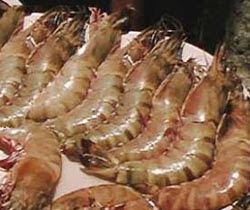I’m thinking back to the shrimp boat scenes in the movie "Forrest Gump" and I seem to remember a few shots of the shrimp haul by his boat where this huge netfull of shrimp is dumped on board. How easy it seemed: Drag a net for a while along the bottom and pull up a few thousand pounds of ready to eat crustaceans. Sadly, in reality this is not the case.
Most shrimp fishing is done using an otter trawl. This is a fine-meshed net dragged behind a boat which skims the ocean bottom in hopes of scooping up as much shrimp as possible in each pass. An otter trawl may have an opening up to sixty feet wide as it scours the ocean bottom picking up anything in its path. The shrimp you eat are benthic animals that live among grass beds, coral reefs and sandy bottoms. They are not free-swimming animals like their relatives the krills, famous as the main staple of baleen whales.
Otter trawl
Benthic otter trawling is perhaps the single most destructive type of fishing method when it comes to "bycatch". This term refers to the unwanted fish and invertebrates that are caught along with the target species. You would think that bycatch would be easy to deal with since you could simply throw back what you don’t want and keep the rest. But this is not how it works. For several reasons.
First we have productivity. Boat owners depend on a certain tonnage of sellable catch to cover their costs and hopefully make a profit. When you consider that a shrimp boat’s haul may contain as much as ten pounds of bycatch for every pound of shrimp, no businessman in his right mind would pay his crew to take the time and energy needed to release the unwanted animals unharmed. Economics dictates that you freeze the targeted catch as soon as possible and get the net back in the water.
Second, although shrimp may be found in dense numbers in favorable habitats, they do not form schools as many commercial finfish do, nor do they live in colonies like many species of mollusks. To catch a worthwhile amount of an animal with behaviors like shrimp requires the boat to cover a lot of ground. Covering a lot of ground means that many, many non-target species get caught up as well.
Third, even if some ecologically-minded boat owner decided on a "catch and release" policy for all of the unwanted haul (he’d go broke), the time the bycatch spends out of water before the crew can pick out the valuable shrimp and then release the rest, as well as the injuries caused by being dumped onto a boat deck with thousands of pounds of other creatures, would make survival rates inconsequential.
So, what happens to the bycatch? In general, after all the shrimp have been picked out of the giant pile of biomass on the deck and quickly frozen to preserve them, the crew shovels or hose-sprays the rest of the catch overboard. Pretty much nothing survives. Of course, because the bycatch is left dead and dying at the bottom of the sea these animals are basically out of sight, out of mind. Imagine the outrage if a hunter searching for a deer killed nearly every bird, mammal, reptile and insect in his path. And simply left them lying dead on the ground.
Tropical shrimp live in much more diverse and fragile environments than those species found in the temperate Atlantic or Pacific. The damage that tropical trawling can do to bottom habitats can be summed up simply with a term some ecologists use for the destruction left behind in the wake of a passing shrimp boat: "Coral Decapitation". Temperate shrimp, on the other hand, live in less vulnerable habitats that are able to rebound from the damage done by a trawl (assuming it is given the chance to recover, that is) much quicker than a tropical reef or grass bed.
These Alaskan shrimp are caught
with smaller bycatch problems
than southern varieties.
Now, I’m not dismissing the bycatch issues associated with northern shrimp fishing, but consider this one truism of marine populations: In temperate oceans there is a smaller diversity of species than in tropical oceans, however these northern species occur in denser populations. In other words, a given area of tropical reef may have a thousand species on it but each species has a low population size. A temperate area of equal size may have twenty species living there but each species has many, many individuals.
This is important in two ways. Any deaths from bycatch in a tropical zone will result in a harder hit to the species’ small population. The bycatch of temperate animals will affect fewer species total, and because they inevitably will contain many individuals of each type, the bycatch will more likely be utilized as a marketable catch as opposed to being discarded back into the ocean.
Wild Caught Shrimp
Labels:
Shrimp
Shrimp
Subscribe to:
Post Comments (Atom)
No comments:
Post a Comment